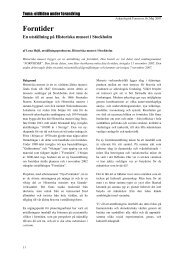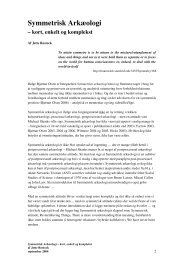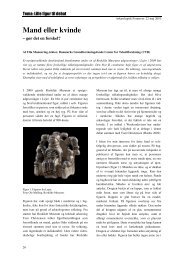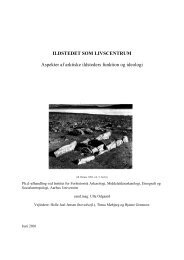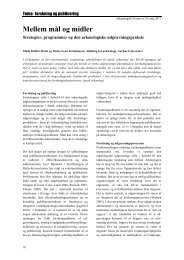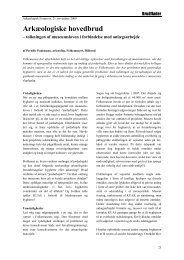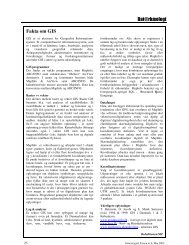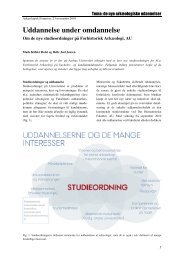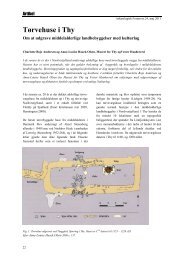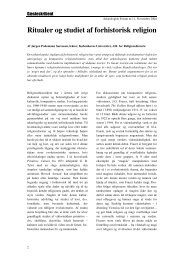Smeltediglerne fra Kvæsthusbroen
Smeltediglerne fra Kvæsthusbroen
Smeltediglerne fra Kvæsthusbroen
You also want an ePaper? Increase the reach of your titles
YUMPU automatically turns print PDFs into web optimized ePapers that Google loves.
English summary<br />
In 2005, I was in charge of the archaeological investigation at <strong>Kvæsthusbroen</strong> in Copenhagen,<br />
where, among other things, 56 <strong>fra</strong>gments of crucibles dated to the period around 1600 to 1750 AD<br />
was found. The crucibles could by subsequent analysis be determined to originate from the German<br />
state of Hesse. Analysis could also reveal, that the crucibles proprably was involved in alchemical<br />
operations.<br />
To illustrate the reseach potential of medieval and post-medieval crucibles the thesis presents a<br />
comparative material from Denmark and abroad.<br />
The comparative material from Denmark includes two archaeological finds of crucibles from<br />
Amalienborg in Copenhagen and the medieval mounds Rovborg near Skælskør. Both findings may<br />
have had a connection to alchemy.. The crucibles from <strong>Kvæsthusbroen</strong> exhibits many similarities<br />
with the crucible from Amalienborg concerning find circumstances, dating, shape and size.<br />
Provenances also have similarities, since both types are produced in Germany. The crucible from<br />
Amalienborg could, through a stamp on the base, be associated to the German state of Bavaria. The<br />
two crucible finds from Copenhagen has fewer similarities with the find from Rovborg which<br />
diverges in dating, shape and size. However, the crucibles from Rovborg has, similarities with<br />
another Danish find, Bjørnkær, related to alchemy. Six Danish sites associated with alchemy,<br />
including Bjørnkær, is presented in the thesis in order to illustrate the research potential in alchemy.<br />
Two archaeological finds from Austria and Switzerland of objects related til alchemy is presented<br />
as foreign comparative material.<br />
English research has shown that there were mainly two dominant producers of crucibles in the<br />
period between 1300-1800.. The production sites were situated in Hesse and Bavaria in Germany<br />
and were major competitors during that period. The crucibles from <strong>Kvæsthusbroen</strong> and the crucible<br />
from Amalienborg originated precisely from these two production sites and thus puts Denmark on<br />
the distribution map that shows the export areas of the German crucibles. A distribution map which<br />
also includes North and South America and large parts of Europe. The thesis presents several sites<br />
from these areas, where archaeological finds of Hessian and Bavarian crucibles had been made.<br />
The thesis also discuss the potential of post-medieval archaeology in Denmark. To illustrate this,<br />
several examples from more recent excavations, which have given new and important knowledge<br />
about the period in Denmark, are presented.<br />
The thesis concludes that medieval and post-medieval crucibles and other archaeological objects<br />
Susanne Møller Johansen. Kandidatspeciale<br />
Forhistorisk Arkæologi<br />
Københavns Universitet 2010<br />
64





